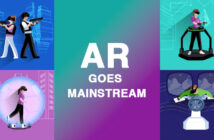Leap Motion dreams big with an ambitious new project that could open ‘alternative dimensions of reality, layered over the physical world’ – Mirrorworldss
American computer hardware manufacturer Leap Motion has released a series of concept videos teasing a technological future where Augmented Reality and Virtual Reality (AR and VR) have collided to form a ‘parallel reality’ of sorts and call it Mirrorworlds.
Dubbed ‘Mirrorworlds,’ these blended realities utilize AR technology to capture and map the real-world, turning physical obstacles such as furniture, the natural environment, even actual people into digital elements that you could then interact within VR. The result is a theoretically-endless virtual playspace that incorporates anything and everything into the experience.
“Mirrorworlds immerse you without removing you from the space. You are still present but on a different plane of reality. You will be able to see and engage with other people in your environment, walk around, sit down on a chair. But you can also shoot fireballs, summon complex 3D models, or tear down your walls to look out on a Martian sunrise. Mirrorworlds re-contextualize your space. They change its meaning and purpose, integrating with our daily lives while radically increasing the possibilities for space.”
Leap Motion hopes the ambitious concept will provide high levels of social interactivity within immersive technology, as opposed to more isolating VR experiences.
“At a basic level, we may just be aware of other people’s presence by making out their shape,” continues Matsuda. “In time, devices will be able to recognize these shapes as people and replace them with avatars. In both cases, your social context is preserved. You will be able to stay engaged with the people and environment around you. In fact, we could say that Mirrorworlds move us away from human-computer interfaces, and towards human-environment interfaces, with technology as a mediating filter on our perception.”
Whether it be a doctor providing remote consultation during a live surgical operation, or an unmotivated jogger gaining some much-needed motivation thanks to an oncoming horde of virtual zombies, these blends of AR and VR could revolutionize countless industries.

As for when you can expect this kind of ambitious technology to hit the market, Matsuda remains optimistic:
“This future is closer than you might think. It’s largely possible on today’s hardware, and now the limitations are less about technical constraints, and more in our ability to conceptualize, structure and prioritize the aspects of the world we want to build.”
Did we miss something? If you have any extra tips, please share them in the comments below.








